FOCUS: Paddlers surround Crab Bank sanctuary
COMMENTARY, Brack: Lessons from 17 years of offering S.C. commentaries
IN THE SPOTLIGHT: Charleston Gaillard Center
PALMETTO POEM, Rutledge: On the Fourth Day
FEEDBACK: Send us your comments … share your thoughts
MYSTERY PHOTO: Might be easy, but might not
S.C. ENCYCLOPEDIA: Santee National Wildlife Refuge
CALENDAR: Sign up to host a Lowcountry On the Table gathering
FOCUSFOCUS: Paddlers surround Crab Bank rookery
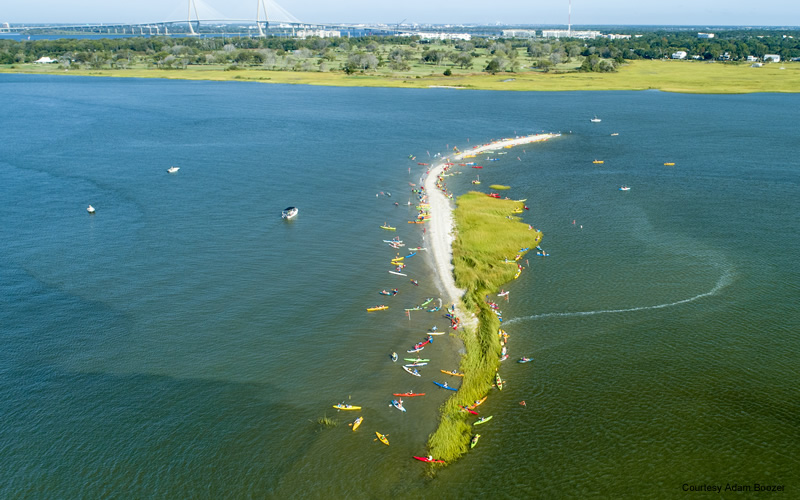
Image courtesy of Adam Boozer. On Instagram here.
Staff reports | U.S. Rep. Mark Sanford, R-S.C., and conservationists on Sunday surrounded Crab Bank, an eroding spit at the mouth Shem Creek, to illustrate how it should be protected as a seabird sanctuary.
Renourishment of the rookery may be the only way to save it, according to this story.
In March, Sanford and other congressmen sent a letter to the U.S. Army Corps of Engineers requesting that the Crab Bank Seabird Sanctuary be included in as a pilot project for revitalization.
In a statement, he said, “At just 2 percent of its original size, the Crab Bank Seabird Sanctuary is in danger of disappearing altogether. Interestingly, however, restoring the Crab Bank may be as easy as looking to its formation. Indeed, in the 1950s, the Crab Bank was formed from sediment dredged from the Charleston harbor. With the Charleston Deepening Project well on its way, it seems like the perfect time to rebuild.
“On a historic level, revitalizing the sanctuary is pressing now because scientists predict that, without changes, there will be no nesting on the island within the year. What a shame when pelicans have been in Charleston harbor since at least 1789. And from a practical level, rebuilding the Crab Bank will act as a buffer to prevent erosion for parts of Mount Pleasant.”
The Sunday flotilla included members of the S.C. Coastal Conservation League, Coastal Expeditions, local outfitters, conservation partners, and others.
“Right now, our community has a once-in-a-lifetime chance to rebuild the bank, using sand dredged from the Charleston Harbor deepening project — if we act quickly,” according to a statement by the Coastal Conservation League. “Restoring Crab Bank will require $1.5 million in local matching funds by December. You can learn more at sccoastalbirds.org.”
Crab Bank is home to at least 15 species of birds including brown pelicans, skimmers, terns and oystercatchers. Through the years, it has eroded to a one-acre spit.
- Have a comment? Send to: editor@charlestoncurrents.com
BRACK: Lessons from 17 years of offering S.C. commentaries
Commentary by Andy Brack, editor and publisher | After more than 850 weekly columns totaling more than 600,000 words over 17 years, I’m like the Farmers Insurance guy – I’ve seen a thing or two.
 And I’ve learned a thing or two about how politics, policy and governance works – and doesn’t – in the Palmetto State. Now with elections around the corner, maybe it’s time to share some of the bigger lessons.
And I’ve learned a thing or two about how politics, policy and governance works – and doesn’t – in the Palmetto State. Now with elections around the corner, maybe it’s time to share some of the bigger lessons.
The state’s taxes are too low. Some politicians yell you can’t throw money at things and fix them. Hogwash. After two decades of tax cut after tax cut by the GOP, the state’s tax base has eroded too much for lawmakers to be stewards of the public trust. If you believe you can’t throw money at things and fix them, consider why we have failing schools, inadequate health care access, crumbling infrastructure, university buildings that need hundreds of millions of dollars in maintenance, roads with years of backlogs to get fixed and more. Had there been enough money in a climate that promoted planning and fiscal responsibility, we wouldn’t be in the messes we are in.
South Carolina has become more like Washington. Partisanship and nastiness are increasing. Thanks to gerrymandered districts and political theatrics that have drifted from Congress to states, voters have too many choices of fringe candidates and not enough moderates. Politics should be an exercise in seeking compromise for the good of all people, not a steady stream of bluster, hemming and hawing.
State lawmakers often ignore the big issues. Legislators know in their guts that poverty in South Carolina is the root of most of our problems, yet they seem to ignore it. At election time, they’ll talk about education or health care or roads. They’ll work hard as hell to keep their power. But when it comes time to do the work in the halls of the Statehouse, they don’t really do that much for the common good. Too many take a walk or ignore looking for real solutions that will make a difference to South Carolinians who live on the edge, paycheck to paycheck.
Political parties are in the way. The state Democratic and Republican parties seem to be shells of their former selves. Two decades ago, they played a bigger game in elections and in day-to-day grind about politics and policies. Now they’re underfunded and understaffed. They seem to have less impact on the debate, which dulls the discourse. Some might argue that better leadership is needed. It might be, however, that we all get information from so many sources that we don’t have as much use for attempts by parties to influence us.
More civility is needed. After the melodrama on display this week in Washington, it’s clear more politicians are talking at each other than with each other. Our democracy, in South Carolina and Washington, can’t become stronger if we don’t respect and trust each other and spend time talking to hammer out compromises.
The little guy still is getting the shaft. In a patriarchal culture like South Carolina’s, those in power continue to support policies and tax breaks that benefit the establishment – big business, rich donors and the social elite. While the little guy has the power to make those in power tumble, too many voters are manipulated through fear and division by pandering politicians. Too many people vote against their economic interests because they focus on the tiny, not the bigger, picture.
State employees are paid too little. There are fewer of them than 20 years ago and they’re being asked to do more. We want them to teach our kids, protect our state and keep commerce moving. But we don’t honor them with wages that reflect their value.
Good people. Of course, these lessons are generalities. There are a fair number of Republicans and Democrats who “get it” and work to make things better. And there are a whole lot of people in state government who are just plain good. But they’re fewer and far between in the everyday tumble of Columbia. Let’s hope more reasonable people get elected in the fall.
- Have a comment? Send to: editor@charlestoncurrents.com
SPOTLIGHT: Charleston Gaillard Center
 Charleston Gaillard Center provides the Lowcountry with a world-class performance hall, elegant venue space and vibrant educational opportunities that inspire dynamic community throughout the area through the power of the performing arts. The Center’s vision is to enrich the diverse community of Charleston with artistic and cultural experiences that are accessible and unique, and to serve as an educational resource for generations to come.
Charleston Gaillard Center provides the Lowcountry with a world-class performance hall, elegant venue space and vibrant educational opportunities that inspire dynamic community throughout the area through the power of the performing arts. The Center’s vision is to enrich the diverse community of Charleston with artistic and cultural experiences that are accessible and unique, and to serve as an educational resource for generations to come.
Did you know that the Charleston Gaillard Center is a 501c3 non-profit that works with over 25,000 students each year from the tri-county area? Promoting education is one of the core values of the Charleston Gaillard Center and an integral part of our mission. By broadening the reach of arts-education in the Lowcountry the Gaillard Center encourages learning through the arts and serves as a powerful tool for student achievement and personal development while providing people of all ages with the opportunity to cultivate and grow their talents and appreciation for the arts. To learn more about our education initiative, click here: www.gaillardcenter.org/outreach.
For more information, click the links below:
- Buy ticketsand see our great events
- Become a membertoday
- Plan your eventat the Charleston Gaillard Center
- Learn aboutour education and community programs h
- Contact the Gaillard Center.
POEM, Rutledge: On the Fourth Day
By Jeremy Rutledge, special to Charleston Currents
On the fourth day
of physical therapy
the material
turned to metaphor
![]() all of us working
all of us working
to find our weaknesses
and give them
our attention.
So much laughter
from those
having trouble
maintaining balance
or holding that side plank
for ten seconds more
as an arm quivers
under the strain.
But the only way
to address our pain
is to find the weakness
causing it.
Would that it were so
in our faith
and politics.
Can you imagine
if instead of hiding
our pain
and denying
our weaknesses
we worked on them
every day
all of us together
laughing?
Jeremy Rutledge is the senior minister at Circular Congregational Church in Charleston and the co-president of the Charleston Area Justice Ministry. Jeremy was formally educated in philosophy and theology. While living in Houston, he studied with the Inprint community of poets and writers.
FEEDBACKSend us your thoughts or what you love
We’d love to get your impact in one or more ways:
Send us a letter: We love hearing from readers. Comments are limited to 250 words or less. Please include your name and contact information. Send your letters to: editor@charlestoncurrents.com. | Read our feedback policy.
Tell us what you love about the Lowcountry. Send a short comment – 100 words to 150 words – that describes something you really enjoy about the Lowcountry. It can be big or small. It can be a place, a thing or something you see. It might the bakery where you get a morning croissant or a business or government entity doing a good job. We’ll highlight your entry in a coming issue of Charleston Currents. We look forward to hearing from you.
MYSTERYMYSTERY PHOTO: Might be easy, but might not
At first glance, this might seem easy to many, but where actually was the photo taken? Send your guess to: editor@charlestoncurrents.com. And don’t forget to include your name and the town in which you live.
Our previous Mystery Photo
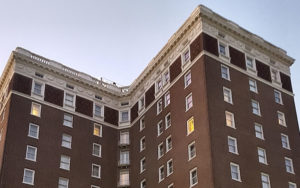 Our Sept. 24 mystery looked like the top of the Francis Marion Hotel to some, but it was actually the top of the Francis Marion’s former sister, the Westin Poinsett Hotel in Greenville.
Our Sept. 24 mystery looked like the top of the Francis Marion Hotel to some, but it was actually the top of the Francis Marion’s former sister, the Westin Poinsett Hotel in Greenville.
Congratulations to this week’s photo sleuths: George Graf of Palmyra, Va.; Bill Segars of Hartsville; Charlie Morrison of James Island; Chris Brooks of Mount Pleasant; Marnie Huger of Richmond, Va.; and Susan McBrayer of Sugar Hill, Ga./
Segars writes: “This building is one of the first skyscrapers, 12 stories tall, in South Carolina. Located at 120 S. Main St. in downtown Greenville, the Poinsett Hotel was designed by William L. Stoddard and built by the J.E. Sirrine Company of Greenville. When it was completed in 1925, it cost $1.5 million. Its interior featured many amenities not typically found in hotels of this era: a ballroom, a convention center, main and private dining areas, shops and stores and, best of all, 210 guest rooms each with a private bath.
Graf provided additional information: “According to Wikipedia.com: ‘Built at the end of an era during which small Southern cities demanded quality hotels to attract business travelers and symbolize their new urban status, the Poinsett Hotel was, in part, conceived to accommodate visitors to a biennial Southern Textile Exhibit held in Greenville. A century-old hotel, the Mansion House, was razed and a larger building was designed for its Main Street location by noted New York architect William Lee Stoddart. To help raise money for the project, local businessmen, led by textile magnate John T. Woodside (1864-1946), sold $100 shares of stock to 1,700 local residents; and the hotel was named for Joel R. Poinsett, a South Carolinian who had served as Secretary of War and as the first U.S. Minister to Mexico. Groundbreaking occurred in May 1924; and the $1.5 million Poinsett Hotel opened in June 1925.’
“According the University of Virginia Miller Center, Poinsett was appointed Secretary of War by President Martin Van Buren (1837-1841), and Poinsett spearheaded a number of bloody Indian campaigns and forced resettlements in the South. Joel Poinsett founded the Academy of Fine Arts in Charleston and later died in Sumter County, South Carolina, on December 12, 1851.”
Send us a mystery: If you have a photo that you believe will stump readers, send it along (but make sure to tell us what it is because it may stump us too!) Send it along to editor@charlestoncurrents.com.
S.C. ENCYCLOPEDIAHISTORY: Santee National Wildlife Refuge
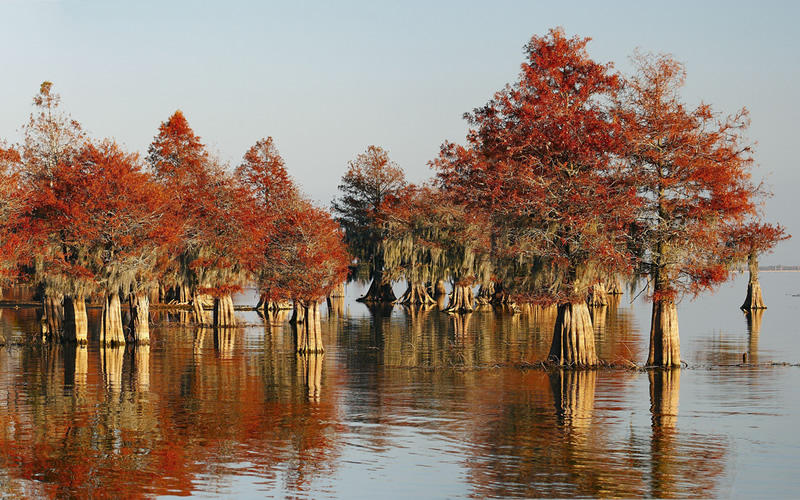
U.S. Fish and Wildlife Service photo via Flickr.
S.C. Encyclopedia | Established in 1942, Santee National Wildlife Refuge (NWR) was created to alleviate the loss of natural waterfowl and wildlife habitat caused by the construction of hydroelectric projects on the Santee and Cooper Rivers. Management and protection are provided for 15,095 acres that stretch for eighteen miles along the northern shore of Lake Marion in Clarendon County.
The area includes more than ten thousand acres of open water and freshwater marsh along with mixed hardwoods and pines, croplands, old fields, ponds, and managed impoundments. Significant waterfowl concentrations winter on the refuge, as do other birds of interest. Santee Refuge overwinters the largest group of Canada geese belonging to the Southern James Bay population in South Carolina. With recorded observations of 296 species, the refuge is one of the best inland birding areas in the state.
Santee NWR includes four units, each with its own unique characteristics. The Bluff Unit is home to the Santee Indian Mound, which dates back more than 3,500 years. The mound is also the site of Fort Watson, which was an important British encampment during the Revolutionary War. Dingle Pond is home to a Carolina bay and provides unique habitat for several wetland species including alligators, wood ducks, mallards, great blue herons, and other wading and song birds. Pine Island provides protection and habitat for American alligators, numerous species of wading birds, and nesting bald eagles and is home to thousands of wintering ducks, geese, and swans. The Cuddo Unit includes mixed hardwood and pine woodlands, numerous freshwater impoundments and marshes, and several old-field and cropland sites. Bird life is abundant, as are alligators and many other native species.
Santee NWR promotes conservation and stewardship by providing wildlife-dependent recreational opportunities and offers environmental education programs. Interpretive exhibits in the visitors’ center provide an orientation to the refuge. Visitors can explore the refuge on several miles of hiking trails or on an auto drive. Fishing and hunting are permitted during designated seasons in accordance with special refuge regulations.
— Excerpted from an entry by Kay W. McCutcheon. This entry hasn’t been updated since 2006. To read more about this or 2,000 other entries about South Carolina, check out The South Carolina Encyclopedia, published in 2006 by USC Press. (Information used by permission.)
ON THE CALENDARCALENDAR: Sign up to host a Lowcountry On the Table gathering
Staff reports | You’re encouraged to host a small-group discussion in your home, at your church, in a local restaurant or in a library anytime on Oct. 4 to take part in Lowcountry On The Table, a citizen-driven process to identify issues and suggest solutions.
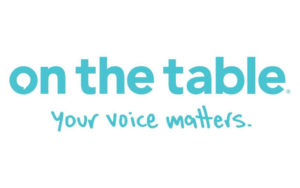 Organizers of the tri-county event, the Library Foundation of the Lowcountry, are hoping to engage thousands of area residents in what could be considered a huge local focus group to provide input to local nonprofits and governments on what people believe really matters in the Lowcountry.
Organizers of the tri-county event, the Library Foundation of the Lowcountry, are hoping to engage thousands of area residents in what could be considered a huge local focus group to provide input to local nonprofits and governments on what people believe really matters in the Lowcountry.
Open to the public, the day-long event invites thousands of residents and “table hosts” to break bread while discussing and recording ways to make the Lowcountry a better place. Top ideas and recommendations from Oct. 4 will be awarded Spark grants to enact change, made possible from the Library Foundation of the Lowcountry.
Determine a location for friends, family, colleagues, and neighbors to meet for a mealtime conversation on Thursday, Oct. 4. This could be at a restaurant, over a home-cooked meal, a potluck, cups of coffee or whatever works for a (recommended) group of 8-12 people.
Visit www.lowcountryonthetable.org/hosting to register as a host, subscribing for weekly updates on how to deliver a meaningful experience. Hosts will be encouraged to gently guide their table’s discussion to wherever their guests want to go, while providing materials to record key topics.
- For more information visit lowcountryonthetable.org, call (843) 608-1223 and follow updates on Twitter, Facebook or Instagram. The official hashtag for the event is #OnTheTableSC.
Also on the Calendar:
Latin American Festival: Noon to 6 p.m., Oct. 14, Wannamaker County Park, North Charleston. Dive into the vibrant Latin American culture for a day this popular that will feature Latin American music, dance, art, food and children’s activities. Plena Libre will headline this festival followed by various musical performances and demonstrations by Latin America’s best artists. More info.
PSC ratepayer public hearing: 6 p.m., Oct. 15, Lonnie Hamilton III Public Services Building, 4045 Bridgeview Drive, North Charleston. The S.C. Public Service Commission hold a hearing for South Carolina Electric & Gas customers to air grievances over nuclear surcharge rates. More about the meeting.
Georgetown Wooden Boat Show: 11 a.m. to 6 p.m., Oct. 20; 11 a.m. to 4 p.m., Oct. 21, Georgetown, S.C. Celebrate wooden boats and boating at this community-wide festival that features one of the Southeast’s best wooden boat exhibits with more than 140 classic wooden boats displayed on land and water, children’s model boatbuilding, knot tying, maritime art and crafts, food and music. Free. Learn more online.
C4WNEW: Nov. 15-16, Trident Technical College, North Charleston. This event, the Center for Women’s annual conference, will feature author Elizabeth Gilbert as special guest. To learn more or buy tickets, click here.
Early morning bird walks at Caw Caw: 8:30 a.m. every Wednesday and Saturday, Caw Caw Interpretive Center, Ravenel. You can learn about habitats and birds, butterflies and other organisms in this two-hour session. Registration not required, but participants are to be 15 and up. $10 per person or free to Gold Pass holders. More: http://www.CharlestonCountyParks.com.
AREA FARMERS MARKETS
SATURDAYS: The Charleston Farmers Market, is back in action from 8 a.m. to 2 p.m. every Saturday through Nov. 24 at Marion Square. A holiday market will be open Dec. 1, 2, 8. 9, 15 and 16.
SATURDAYS: Johns Island Farmers Market operates each Saturday from 9:30 a.m. to 1:30 p.m. year-round with more than 50 local farmers and vendors, food trucks, music and more. The market is located on the campus of Charleston Collegiate School, 2024 Academy Road, Johns Island.
SATURDAYS: The Town Market on James Island are again open. Open 9 a.m. to 1 p.m. every Saturday at the James Island Youth Soccer Club, 871 Fort Johnson Road, James Island.
WEDNESDAYS. The West Ashley Farmers Market, 55 Sycamore Ave., is open every Wednesday from 3 p.m. to 7 p.m. in Ackerman Park. More.
- If you have an event to list on our calendar, please send it to charlestoncurrents@gmail.com for consideration. The calendar is updated weekly on Mondays.
If you like what you’ve been reading, how about considering a contribution so that we can continue to providing you with good news about Charleston and the Lowcountry. Interested? Just click the image below.
ABOUT CHARLESTON CURRENTS
OUR UNDERWRITERS
Charleston Currents is an underwriter-supported weekly online journal of good news about the Charleston area and Lowcountry of South Carolina.
- Meet our underwriters
- To learn more about how your organization or business can benefit, click here to contact us. Or give us a holler on the phone at: 843.670.3996.
OUR TEAM
Charleston Currents offers insightful community comment and good news on events each week. It cuts through the information clutter to offer the best of what’s happening locally.
- Mailing address: O. Box. 22261 | Charleston, SC 29413
- Phone: 670.3996
Charleston Currents is provided to you weekly by:
- Editor and publisher: Andy Brack, 843.670.3996
- Contributing photographer: Michael Kaynard
- Contributing editor, common good, Fred Palm
- Contributing editor, money: Kyra Morris
- Contributing editor, Palmetto Poem: Marjory Wentworth
SUBSCRIBE FOR FREE
Subscriptions to Charleston Currents are free.
- Unsubscribe. We don’t want to lose you as a reader of Charleston Currents, but if you must unsubscribe, you will have to do it through the email edition you receive. Just go to the bottom of any of your weekly newsletters and click the “unsubscribe” function. If that doesn’t work, please send us an email with the word “unsubscribe” in the subject line.
© 2008-2018, Statehouse Report, LLC. All rights reserved. Charleston Currents is published every Monday by Statehouse Report LLC, PO Box 22261, Charleston, SC 29413.




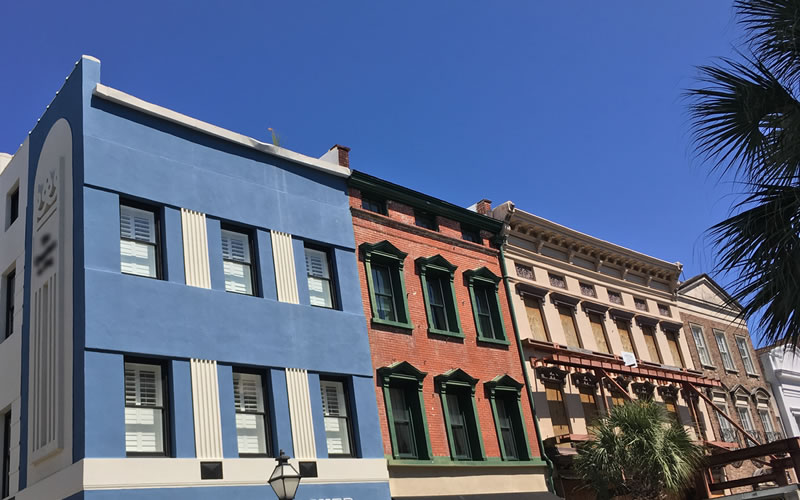

 We Can Do Better, South Carolina!
We Can Do Better, South Carolina!
























